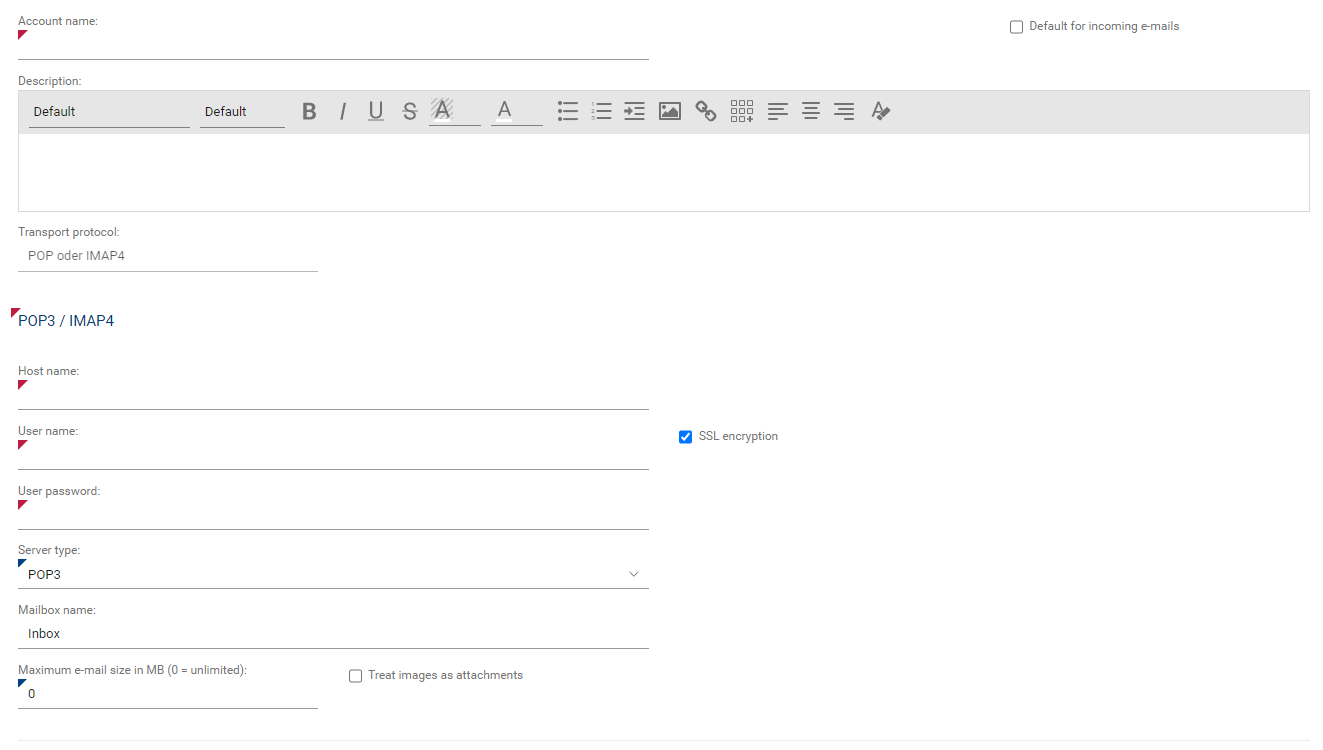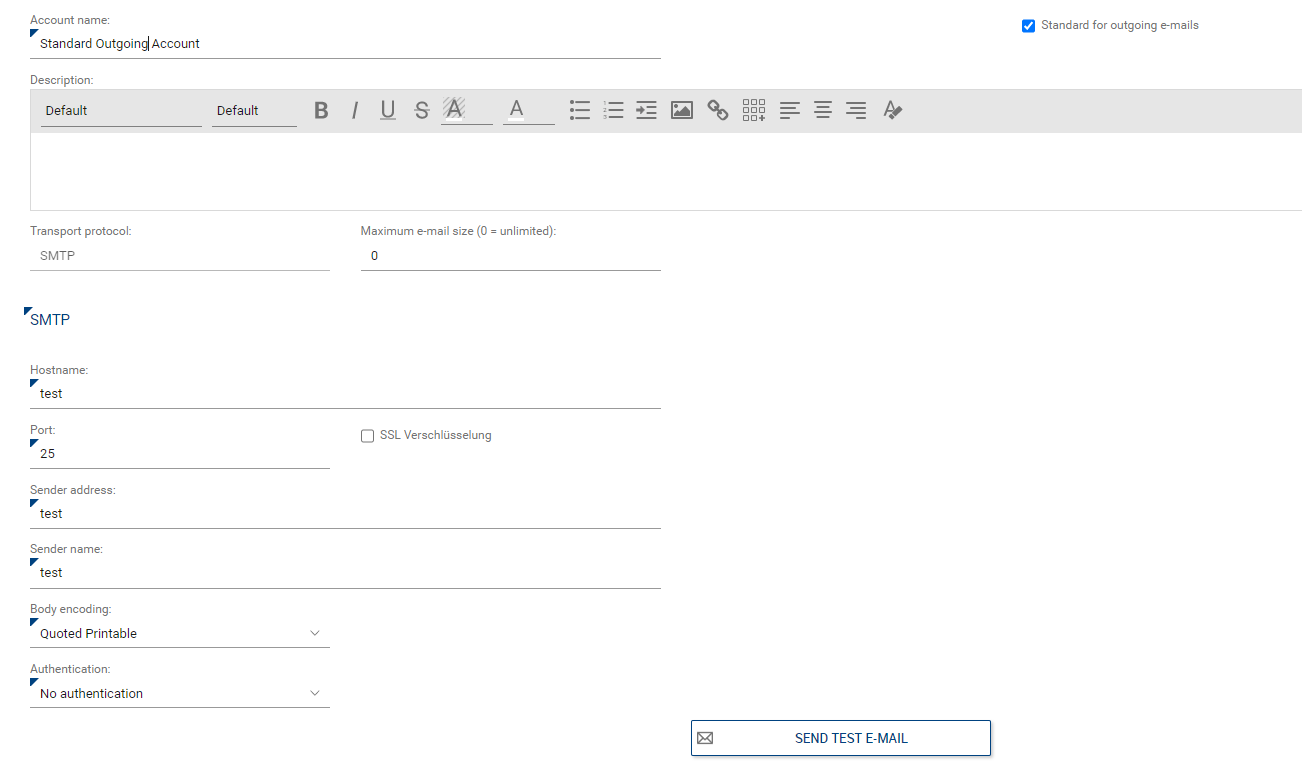E-mail is the most used and most important communication method in the ticketing system and is mainly intended for manual and automated notification and the confirmation of ticket contents.
Any number of incoming and outgoing e-mail mailboxes can be connected in the system, so that e.g. ticket type or processing group specific mailboxes can also be used.
Currently, the protocols POP3 or IMAP4 or SMTP are supported (direct support of Office365 accounts will follow in a later release).
Incoming e-mail accounts
Incoming e-mails are retrieved from the e-mail inbox (thus also removed there). The polling for the retrieval of new e-mails is approx. 5 minutes.
In the ticketing system, the e-mails are first imported as new objects into the e-mail inbox and, if necessary, automatically processed there depending on the set rule (creation of new ticket, assignment to existing ticket, etc.). Then, they are moved to the inbox archive.
Technical settings per account
The list shows all existing incoming accounts.
The "asterisk" button can be used to create a new account.
The incoming accounts have the following fields for setup:
•Account Name: (mandatory field) Individual name for administration in the ticketing system.
•Description: Description text to help the administrator
•Host name; User name and User password (mandatory fields): The data to access your e-mail system
•SSL encryption: Activation to enable SSL - encrypted communication to the email account. This must be enabled on your e-mail system accordingly (Recommended)
•Server type (mandatory field): Default protocol used by your e-mail server (POP3 or IMAP4).
•Mailbox name: Name of the mailbox, Note: it is important to use the same mailbox (inbox) name of your e-mail system.
•Maximum e-mail size: (mandatory field): Maximum allowed size of incoming e-mails, if this should be limited (0 = unlimited).
•Treat images as attachments: Option to remove images embedded in the e-mail body and attach them to the e-mail or ticket.

|
Note: The activation of a new e-mail account may take a few minutes. Please test the successful connection by simply sending test e-mails to this mailbox after about 5 minutes. If you have not made any other settings, the e-mail should arrive in the mailbox of the ticketing system (consider the polling interval of up to 5 minutes after sending the e-mail for synchronization with the e-mail server). If the test e-mails have not been received after 15 minutes at the latest, check the entered data for host name, user name and user password again for correctness, or try to create a new account (you can delete the old account from the list at any time). |
|
Note: If you use Exchange Online (Office365) as your e-mail server, you will no longer be able to use POP3/IMAP protocols there in conjunction with the ticketing system as of October 2022. Microsoft is disabling some functions here. Please only use our connection option for Exchange Online in connection with the use of Exchange Online. |
Settings for Exchange Online
For Exchange Online, other options need to be populated and additional appropriate options need to be enabled or set up in your Azure portal as well. Exchange Online uses modern and more secure authentication methods. For authentication, we only support the so-called "application secret key".
|
Note: The help presented here for setting up your Exchange Online account in your own Office365 tenant is only general advice at the current time of writing this help article. Changes can be made by Microsoft at any time. The ticketing system cannot and may not provide support for the settings in your individual Office365 account, please contact your internal system administrator. |
When creating a custom application in Azure, use the "Integrate any other application not found in the catalog" option.
Settings form within the Ticketing System Administration:
The incoming accounts have the following fields for setup:
•Account Name: (mandatory field) Individual name for administration in the ticketing system.
•Description: description text to help the administrator
•Email: the used email address of the Exchange Online user
•Instance URL: This is the general login page for your Exchange Online (https://login.microsoftonline.com)
•Tenant ID: this is your tenant number in Azure. Log in to your Azure environment. Now go to the "Azure Active Directory" and continue to the "App Registrations" menu item. There, select "all applications" and click on the application you have set up for Exchange Online. Here you will find its Tenant ID ("Directory ID (Client)").
•Client ID: The Client ID ("Application ID (Client)") can be found in the same overview as the Tenant ID.
•Application Secret Key: The key can be found under "Zertifikate & Geheimnisse" / "Certificates & Secrets" within the Exchange Online application that has been set up. Click on the tab "Client Secrets". There you will find a description, a value and a Secret ID. You need the value (not the ID) as Application Secret Key. If there is no entry yet, create a new Secret here. ATTENTION: The value of the secret will be displayed only once, so you should copy it immediately and store it in a secure password environment.
Required permissions in Azure
In order for Exchange Online to allow access from the ticket system, the appropriate read and write permissions must be granted. Please contact your internal administrator of your Azure environment.
In order for the email processing to work correctly, the registration requires at least the following API permissions:
•Read email (Mail.Read, Mail.ReadBasic, Mail.ReadBasic.All)
•Read and write access to email (Mail.ReadWrite)
•Send email on your behalf (Mail.Send)
•Sign up and read your profile (User.Read.All)
Please note that the "Public client flow" must be enabled for all registered Azure applications used for the connection in the mail settings for the ticket system. (via "Authentication")
Functional settings per account
Since any number of incoming e-mail accounts can be created, they can be used for different or dedicated purposes.
Via the settings tile "e-mail rules", you can optionally define functional settings for each incoming e-mail account, which control the automatic processing of incoming e-mails.
•
Outgoing e-mail accounts
All e-mails sent from a process (mostly from ticketing) are sent via an outgoing e-mail account.
As with incoming e-mail accounts, any number of outgoing e-mail accounts can be created and used for different functional purposes.
Technical settings per account
The list shows all existing outgoing accounts.
The "asterisk" button can be used to create a new account.
The outgoing accounts have the following fields for setup:
•Account Name: (mandatory field) Individual name for administration in the ticketing system.
•Default for outgoing e-mails: An outgoing e-mail must be defined as a default account to be used as a fall-back account, if otherwise no rule is defined for the account to be used. There may only be exactly 1 default account. This is used e.g. to send login password changes for the ticketing system to users.
•Description: Description text to help the administrator
•Transport protocol: currently set to SMTP only
•Maximum e-mail size: Maximum allowed size of outgoing e-mails, if this should be limited (0 = unlimited).
•Host name: (mandatory field) Hostname of your e-mail system
•Port: (mandatory field) Port of your e-mail system. The default value is port 587, this can be changed. Important note: Port 25 cannot be used for security reasons and is blocked.
•SSL encryption: Activation to enable SSL - encrypted communication to the email account. This must be enabled on your e-mail system accordingly (Recommended)
•Sender address/ Sender name: (mandatory field) Specification of the address/name under which the system should send e-mails (can be assigned individually)
•Body encoding: (Mandatory field): Encoding version (may depend on your e-mail system)
•Authentication: (Mandatory field) (depending on your e-mail system)
•User/ password for authentication: (mandatory field if authentication is activated)

Functional settings per account
▪Outgoing account per process: Determination which outgoing account is to be used for a specific ticket type (process).
Rules for the use of outgoing accounts. These are to be followed when setting up the desired behavior for sent e-mails:
The system uses the stored outgoing e-mail accounts in the following order. In general, it does not use the user's personal e-mail addresses as senders:
1.Defined outgoing account of the responsible group of the ticket.
2.If the group does not have a defined outgoing account, the account defined per ticket type (ticket process) will be used
3.If no account is defined in the ticket type, the outgoing e-mail account marked as "Default" will be used